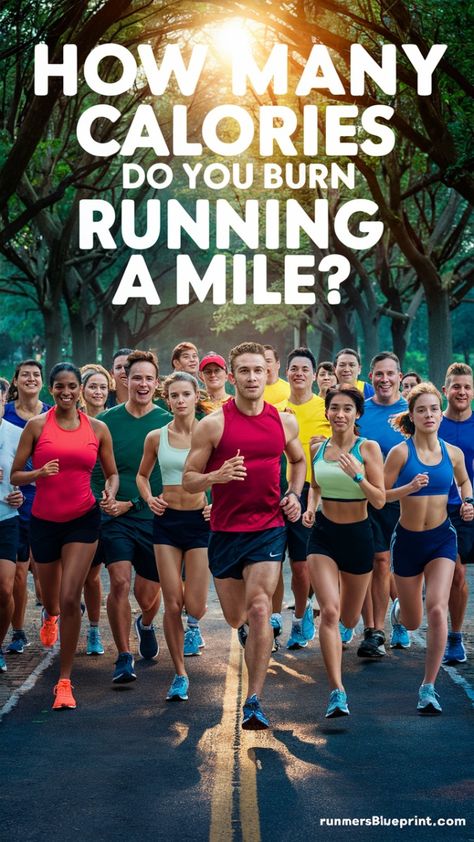Running is a great way to build endurance, tone muscles, and burn off calories
A lot of people start running to lose weight or get fitter because it’s easy to start and really effective
You might have heard that running burns about 100 calories per mile, but it’s actually more complicated.
In reality, your weight and speed both affect how many calories you burn. Heavier runners expend more energy per mile than lighter ones.
For example, a 200-pound runner will burn roughly 142 calories per mile.
Here’s a look at what affects calorie burn during running and some tips to make the most of your runs.
How Many Calories Do You Burn Running?
Most experts say that running a mile burns about 100 calories
But that’s just an estimate; the actual number can vary a lot depending on a few key factors.
Let me explain more.
1. Your Weight
Weight is one of the biggest factors influencing how many calories you burn while running. Heavier runners burn more calories because it takes more energy to move a larger body.
For instance, if you weigh 150 pounds, you might burn about 100 calories per mile, while a 200-pound person might burn around 140 calories per mile.
When I started seriously training for long-distance races, I noticed that my calorie burn per mile also decreased as I lost weight.
If you’re aiming to lose weight, keep in mind you might need to adjust your diet or training as your body changes.
Check the following chart explaining calorie burn for running for an hour at six miles per hour at different weights:
| Weight (lbs.) | Calories |
| 130 | 607 |
| 150 | 700 |
| 170 | 793 |
| 190 | 887 |
| 210 | 980 |
| 230 | 1,074 |
Your Running Speed
Speed also plays a big role in calorie burn. The faster you run, the more energy you use, so you’ll burn more calories.
For instance, for a 150-pound person, running a 12-minute mile might burn around 100 calories, but at an 8-minute pace, they’d burn closer to 150.
Running faster triggers something called EPOC, or Excess Post-exercise Oxygen Consumption. You keep burning calories even after you’ve stopped running. I noticed a significant boost in my overall calorie burn when adding more speed work and intervals into my training.
Your Fitness Level
Here’s the kicker: the fitter you get, the fewer calories you burn doing the same workout. As your fitness improves, your body becomes more efficient, so you might not burn as many calories over time.
I’ve hit this plateau myself, and when that happens, it’s a good idea to switch things up by adding more intensity, intervals, or even resistance training.
Terrain
Running on hills, trails, or rougher surfaces can help you burn more calories. Running 3 miles on a flat surface is relatively easy compared to a hilly route that has you trudging steep ascents.
Challenging surfaces make you use more muscles to keep balanced and upright
And as you can already tell—the higher the effort level, the more calories burned—simple logic.
Weather Conditions
Have you noticed that running in extreme weather—hot or cold—feels tougher? It’s because your body has to work to keep its temperature steady. Cold weather can make your body burn more calories just to stay warm, but extreme heat will have you sweating more and working harder.
Gender
While not as big a factor as weight or speed, gender does play a role. Men usually burn more calories than women during the same workout because they often have more muscle.
However, this difference is relatively small, and other factors like weight and fitness level have a much bigger impact.
Real-World Calorie Burn Examples
Here’s a quick look at how many calories you might burn running at different speeds based on body weight.
Example 1: Running at 5 MPH (12-minute mile pace), flat terrain
- 120 lbs: 90 calories/mile
- 140 lbs: 100 calories/mile
- 160 lbs: 115 calories/mile
- 200 lbs: 140 calories/mile
Example 2: Running at 5 MPH (12-minute mile pace) with a 5% incline
- 120 lbs: 110 calories/mile
- 140 lbs: 125 calories/mile
- 160 lbs: 145 calories/mile
- 200 lbs: 175 calories/mile
Example 3: Running at 8 MPH (8-minute mile pace), flat terrain
- 120 lbs: 130 calories/mile
- 140 lbs: 150 calories/mile
- 160 lbs: 170 calories/mile
- 200 lbs: 200 calories/mile
How Running Compares to Other Cardio Workouts
Here’s how running stacks up against other forms of cardio in terms of calorie burn over an hour:
- Skipping (moderate pace): 1,000 calories
- Vigorous swimming: 1,000 calories
- Rowing (intense pace): 800 calories
- Brisk walking: 270 calories
- Moderate cycling: 530 calories
- Playing tennis: 530 calories
As you can see, running is right up there with the top calorie-burning activities, especially if you’re running faster or adding inclines.
Tips to Maximize Your Calorie Burn
If you’re looking to squeeze out even more calorie burn from your runs, here are a few tips:
- Incorporate Interval Training: Alternate sprints and recovery periods to spike your heart rate and boost post-run calorie burn.
- Run Hills: Adding an incline will challenge your muscles and increase calorie burn.
- Increase Your Distance: If you’re comfortable at a certain mileage, add a mile or two to your weekly runs.
- Mix It Up: Switch between road, trail, and treadmill sessions to engage different muscles and keep things interesting.
- Focus on Form: Running with proper form can help you run more efficiently and reduce injury risk, allowing you to push harder and burn more calories over time.
Frequently Asked Questions
I know you have many questions on running and calorie burn. Let me address some of the most common ones.
How does running speed affect calorie burn?
Running speed has a direct impact on calorie burn. The faster you run, the more energy (or calories) your body needs to sustain that pace. When you increase your speed, your muscles work harder, and your heart rate rises, which leads to higher calorie burn. For example, running a mile at 7 mph will burn more calories than running that same mile at 5 mph, even though the distance is the same. Remember to pace yourself and find a speed that matches your fitness level to avoid burnout or injury.
Do I burn more calories running on a treadmill or outside?
Generally, running outside burns slightly more calories than running on a treadmill because outdoor conditions add extra challenges. Factors like wind resistance, varying terrain, and small changes in elevation force your body to adapt and work harder. However, you can still get an effective workout on a treadmill by slightly increasing the incline (1% to 2% is ideal) to mimic outdoor conditions and add resistance, which can help boost calorie burn.
How can I increase my calorie burn while running?
To maximize calorie burn, try incorporating interval training, which involves alternating between high-intensity sprints and recovery jogs. This approach challenges your cardiovascular system and keeps your calorie burn elevated even after your run. Another effective strategy is to run on hilly routes or add incline on the treadmill.
Hills engage more muscle groups and require more effort, leading to higher calorie expenditure. Lastly, consistency is key—regularly including these techniques in your running routine will help you see lasting results.
Conclusion: It’s About More Than Just Calories
Whether you’re a beginner trying to shed a few pounds or an experienced runner aiming for that next PR, running is about more than the numbers on your watch or the calories burned. It’s about the progress, the grit, and those little victories you feel with every step.
So don’t just run for the calories—run for the joy of it, and the rest will follow.
Got questions or comments? Drop them below—I’d love to hear your thoughts and help you on your running journey.



I’m a slower runner, so I’ll have to adjust my expectations when it comes to how many calories I’m burning
I had no idea that heavier runners burn more calories per mile.
Very informative!
This was a really useful breakdown—I’ll definitely be adjusting my calculations going forward.
Thanks for breaking this down so clearly!
Weight and running intensity definitely make a difference!
Great breakdown of calorie burn! I had no idea that weight played such a big role in how many calories are burned per mile. I’m around 180 pounds
It’s interesting how things like body weight and running speed really impact the total
This article cleared up a lot of confusion I had about calorie burn.
This article really helped me understand how to better estimate my calorie burn during runs. I’m lighter, so I now see that I probably burn fewer calories than the general estimates suggest
Super helpful!
Super helpful for tracking my progress more accurately